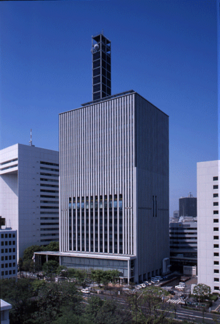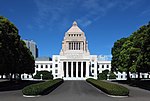Chiyoda
千代田区 | |
|---|---|
| Chiyoda City | |
 Location of Chiyoda in Tokyo | |
| Coordinates: 35°41′38.41″N 139°45′12.94″E / 35.6940028°N 139.7535944°E | |
| Country | Japan |
| Region | Kantō |
| Prefecture | Tokyo |
| Government | |
| • Mayor | Takaaki Higuchi |
| Area | |
| • Total | 11.66 km2 (4.50 sq mi) |
| Population (October 1, 2020) | |
| • Total | 66,680[1] |
| • Density | 5,710/km2 (14,800/sq mi) |
| Time zone | UTC+09:00 (JST) |
| City hall address | 1-2-1 Kudanminami, Chiyoda, Tokyo 102-8688 |
| Website | www |
| Symbols | |
| Bird | Cygnus |
| Flower | Sakura |
| Tree | Pinus |


Chiyoda (Japanese: 千代田区, Hepburn: Chiyoda-ku, IPA: [tɕijoda] ), known as Chiyoda City in English,[2] is a special ward of Tokyo, Japan. Located in the heart of Tokyo's 23 special wards, Chiyoda consists of the Imperial Palace and a surrounding radius of about a kilometer (1000 yards), and is known as the political and financial center of Japan. As of October 2020, the ward has a population of 66,680, and a population density of 5,709 people per km2 (14,786 per sq. mi.), making it by far the least populated of the special wards. The residential part of Chiyoda is at the heart of Yamanote, Tokyo's traditional upper-class residential area, with Banchō, Kōjimachi, and Kioichō considered the most exclusive neighbourhoods in the entire city. The total area is 11.66 km2 (4½ sq. mi.), of which the Imperial Palace, Hibiya Park, National Museum of Modern Art, and Yasukuni Shrine take up approximately 2.6 km2 (1 sq. mi.), or 22%.
Chiyoda is known as the economic center of Japan; the districts of Otemachi, Marunouchi and Yurakucho east of the palace (an area colloquially known as "Daimaruyu") house the headquarters of 19 Fortune 500 companies, is the source of roughly 10% of the combined revenue of all Japanese companies,[3] and produced the equivalent of around a quarter of the country's GDP in 2017.[4] With a day population of around 850,000, its day/night population ratio is by far the highest of all municipalities in Japan. Tokyo Station, Tokyo's main inter-city rail terminal and the busiest train station in Japan in terms of scheduled trains, is also located in Chiyoda.

Chiyoda is also the political center of the country.[5] Chiyoda, literally meaning "field of a thousand generations", inherited the name from the Chiyoda Castle, the other name for Edo Castle, which is the site of the present-day Imperial Palace. With the seat of the Emperor in the Imperial Palace at the ward's center, many government institutions, such as the National Diet, the Prime Minister's Official Residence, the Supreme Court, ministries in Kasumigaseki, and agencies are also located in Chiyoda, as are Tokyo landmarks such as Yasukuni Shrine and the Nippon Budokan. Other notable neighborhoods of Chiyoda include Akihabara, Iidabashi and Kanda.
The ward was formed in 1947 as a merger of Kanda and Kōjimachi wards following Tokyo City's transformation into Tokyo Metropolis. The modern Chiyoda ward exhibits contrasting Shitamachi and Yamanote geographical and cultural divisions. The Kanda area is in the core of Shitamachi,[6] the original commercial center of Edo-Tokyo. On the other hand, the western part of the Kōjimachi area typically represents a Yamanote district.
- ^ "Population by District". Tokyo Statistical Yearbook. Retrieved 2022-07-15.
- ^ "Profile Archived 2008-02-22 at the Wayback Machine." City of Chiyoda. Retrieved on December 28, 2008.
- ^ "大丸有エリアのご紹介 « 一般社団法人大手町・丸の内・有楽町地区まちづくり協議会 一般社団法人大手町・丸の内・有楽町地区まちづくり協議会".
- ^ "大手町・丸の内・有楽町地区における公的空間活用と社会実験" (PDF). Mori Memorial Foundation. 10 December 2017. Retrieved 11 July 2020.
- ^ "Pray for Tokyo: Chiyoda". Karis Japan. Archived from the original on July 20, 2014. Retrieved April 20, 2015.
- ^ Kokushi Daijiten Iinkai. Kokushi Daijiten (in Japanese). Vol. 4, page 842 (1983 ed.).









